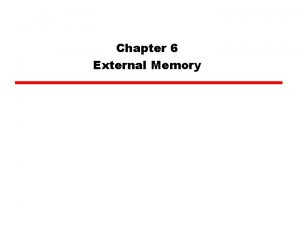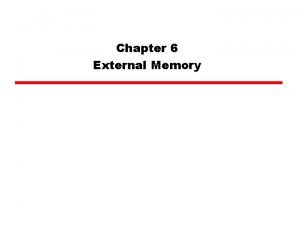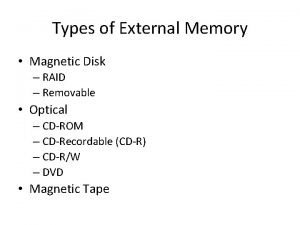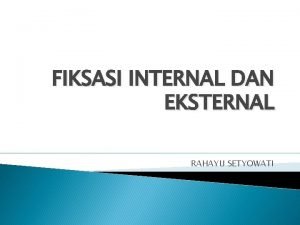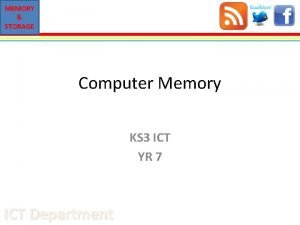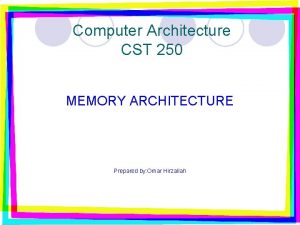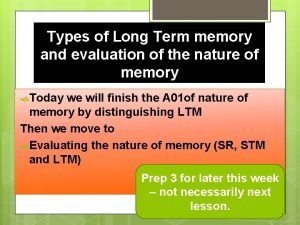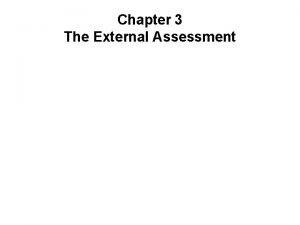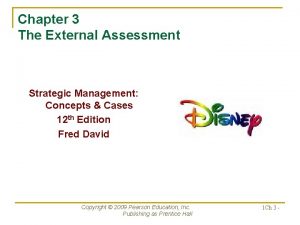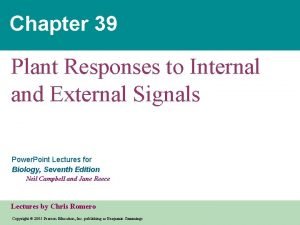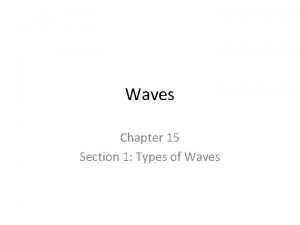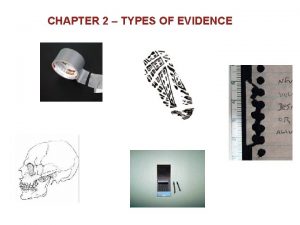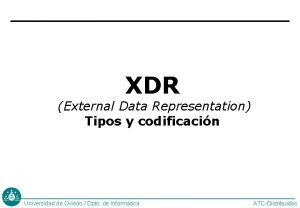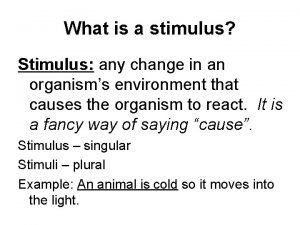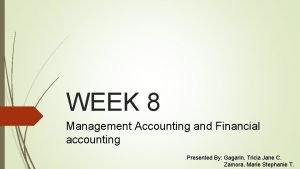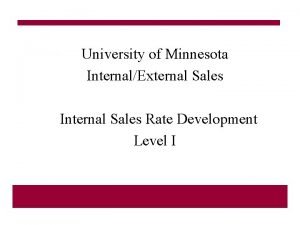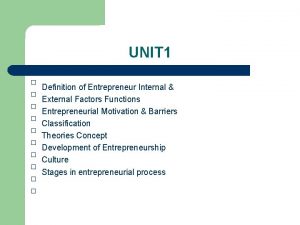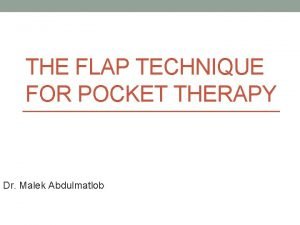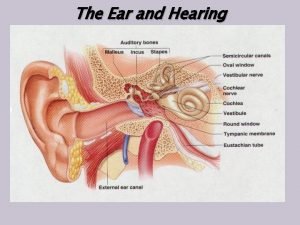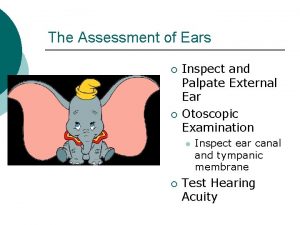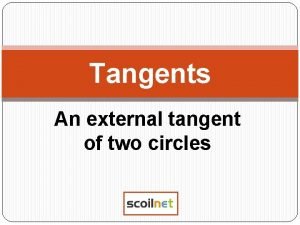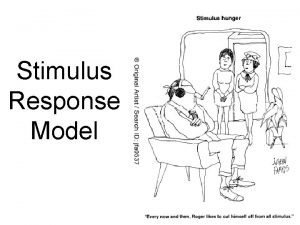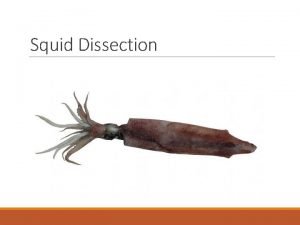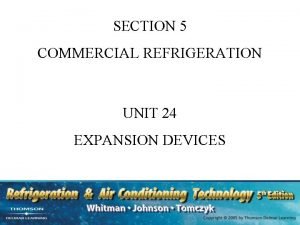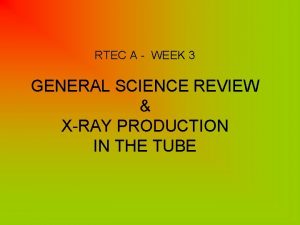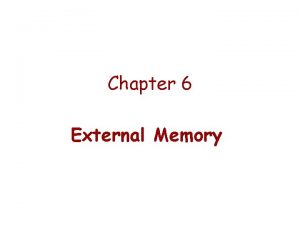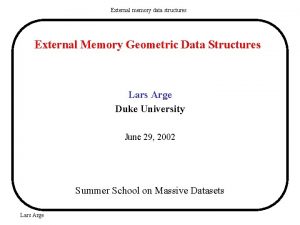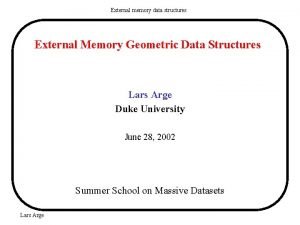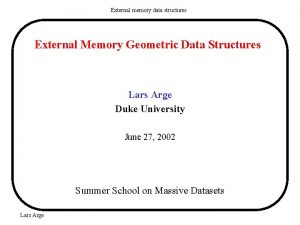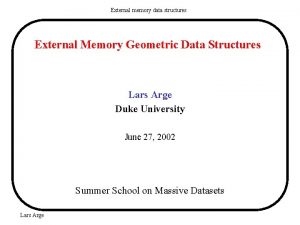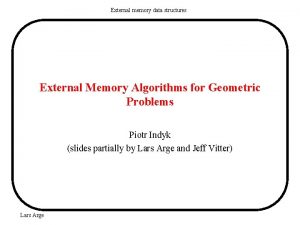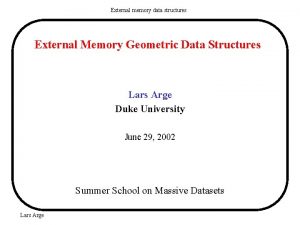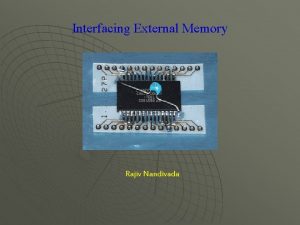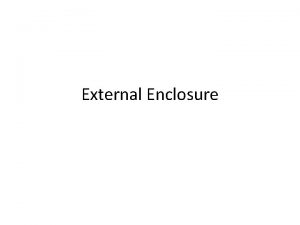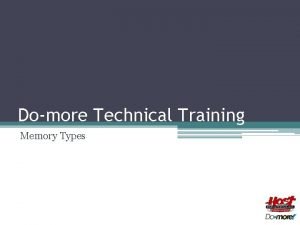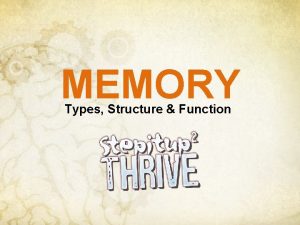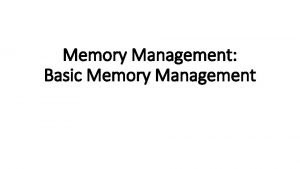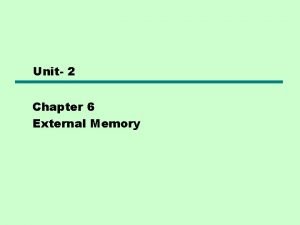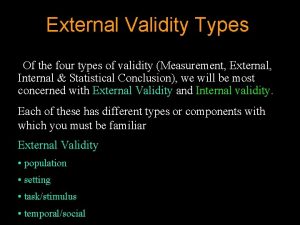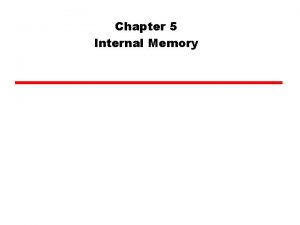Chapter 6 External Memory Types of External Memory





































































- Slides: 69

Chapter 6 External Memory

Types of External Memory • Magnetic Disk —RAID —Removable • Optical —CD-ROM —CD-Recordable (CD-R) —CD-R/W —DVD • Magnetic Tape 2

Magnetic Disk • Disk substrate coated with magnetizable material (iron oxide(Fe 2 O 3)…rust) • Substrate used to be aluminium • Now glass —Improved surface uniformity – Increases reliability —Reduction in surface defects – Reduced read/write errors —Lower flight heights (See later) —Better stiffness (외부변형에 대한 저항강도 vs. strength와 다름) —Better shock/damage resistance 3

Disk Innards http: //www. duxcw. com/digest/guides/hd/hd 4. h 4

Read and Write Mechanisms • • Recording & retrieval via conductive coil called a head May be single read/write head or separate ones During read/write, head is stationary, platter rotates Write — Current through coil produces magnetic field — Pulses sent to head — Magnetic pattern recorded on surface below • Read (traditional) — Magnetic field moving relative to coil produces current — Coil is the same for read and write • Read (contemporary) — Separate read head, close to write head — Partially shielded magneto resistive (MR) sensor — Electrical resistance depends on direction of magnetic field — High frequency operation – Higher storage density and speed 5

Inductive Write MR Read 6

Data Organization and Formatting • Concentric rings or tracks —Gaps between tracks —Reduce gap to increase capacity —Same number of bits per track (variable packing density) —Constant angular velocity • Tracks divided into sectors • Minimum block size is one sector — 512 bytes/sector • May have more than one sector per block 7

Disk Data Layout 8

Disk Velocity • Bit near centre of rotating disk passes fixed point slower than bit on outside of disk • Increase spacing between bits in different tracks • Rotate disk at constant angular velocity (CAV) — Gives pie shaped sectors and concentric tracks — Individual tracks and sectors addressable — Move head to given track and wait for given sector — Waste of space on outer tracks – Lower data density • Can use zones to increase capacity — Each zone has fixed bits per track — More complex circuitry 9

Disk Layout Methods Diagram 10

Finding Sectors • Must be able to identify start of track and sector • Format disk —Additional information not available to user —Marks tracks and sectors 11

Winchester Disk Format (outdated format) Seagate ST 506 12 < ref. Wikipedia>

Characteristics • Fixed (rare) or movable head disk • Removable or fixed disk —Removable disk: can be removed and replaced with another disk • Single or double (usually) sided —Double sided: the magnetizable coating is applied to both sides of the platter • Single or multiple platter • Head mechanism —Contact (Floppy) —Fixed gap —Flying (Winchester) 13

Fixed/Movable Head Disk • Fixed head —One read write head per track —Heads mounted on fixed ridged arm • Movable head —One read write head per side —Mounted on a movable arm 14

Removable or Not • Removable disk —Can be removed from drive and replaced with another disk —Provides unlimited storage capacity —Easy data transfer between systems • Nonremovable disk —Permanently mounted in the drive 15

Multiple Platter • One head per side • Heads are joined and aligned • Aligned tracks on each platter form cylinders • Data is striped by cylinder —reduces head movement —Increases speed (transfer rate) 16

Multiple Platter 17 17

Multiple Platters 18

Tracks and Cylinders 19

Floppy Disk • 8”, 5. 25”, 3. 5” • Small capacity — Up to 1. 44 Mbyte (2. 88 M never popular) • • Slow Universal Cheap Obsolete? 20

Winchester Hard Disk (1) • • • Developed by IBM in Winchester (USA) Sealed unit One or more platters (disks) Heads fly on boundary layer of air as disk spins Very small head to disk gap Getting more robust 21

Winchester Hard Disk (2) • • Universal Cheap Fastest external storage Getting larger all the time — 250 Gigabyte now easily available 22

Typical Hard Disk Drive Parameters 23

Removable Hard Disk • ZIP — Cheap — Very common — Only 100 M (? ), 750 MB • JAZ — Not cheap — 1 G • All obsoleted by CD-R and CD-R/W? 24

Speed • Seek time —Moving head to correct track • (Rotational) latency —Waiting for data to rotate under head • Access time = Seek + Latency • Transfer rate —time required for data transfer • Additional delays —waiting for I/O channels —RPS(Rotation Positional Sensing) 25

Timing of Disk I/O Transfer 26

Parameters • Seek Time — typical average seek time is under 10 ms • Rotation Delay — 15, 000 rpm(rotation per minute) = 250 r/sec – > 1/250 = 0. 004 sec There is one revolution per 4 ms. – Thus, average rotation delay (1/2 r) : about 2 ms • The transfer time to or from the disk depends on the rotation speed of the disk in the following fashion: — T = (b/N)*(1/r) – b : # of bytes to be transferred – N : # of bytes on a track – r : rotation speed, in revolutions (회전) per second • Total average access time — Ta = Ts + 1/(2 r) + b/(r. N) – Ts : average seek time – 1/(2 r) : average rotation delay – b/(r. N) : transfer time 27

A Timing comparison • Disk parameters — — average seek time : 4 ms rotation speed : 7, 200 rpm (average rotation delay = 4 ms) 512 B/sector 2, 500 sectors 5 adjacent tracks 500 sector/track • best case: For 1 st track: 1/(2 r)=4 ms 1/r : 1 track transfer time: 8 ms For 4 succeeding tracks : no seek time needed. 4 tracks * ( avg rotation delay: 4 + track transfer time) = 4 * (4 ms + 8 ms) • Read 2, 500 sectors — Best case — In the case that the file is stored as compactly as possible on the disk. That is, the file occupies all of the sectors on 5 adjacent tracks (5 tracks X 500 sectors/track = 2, 500 sectors) — The time to read the first track : • 4 ms(average seek) + 4 ms(average rotational delay) + 8 ms(first track transfer) — Suppose that the remaining tracks(4 tracks) can now be read with essentially no seek time: • + 4 x(4+8) — Total time: • 4 + 8 + 4 X( 4 + 8) = 64 ms 28

A Timing comparison • Read 2, 500 sectors — Best case – 4 ms(seek) + 4 ms(rotation) + 8 ms(first track transfer) + 4 x(4+8) = 64 ms — Worst case — Now let’s calculate the time required to read the same data using random access than sequential access; that is, accesses to the sectors are distributed randomly over the disk: — For each sector, we have – 4 ms(seek) + 4 ms(rotation) + 0. 016 ms(1 sector transfer) — Total time for 2, 500 sectors, – 2, 500 x 8. 016 ms = 20. 04 sec 29

RAID • First used in 1988 by Patterson, Gibson, and Katz from Berkeley • Redundant Array of Independent Disks • Redundant Array of Inexpensive Disks • 6 levels in common use • Not a hierarchy • Set of physical disks viewed as single logical drive by O/S • Data distributed across physical drives • Can use redundant capacity to store parity information 30

RAID Levels 31

RAID 0 • • • No redundancy Data striped across all disks Striped set without parity Round Robin striping Increase speed — Multiple data requests probably not on same disk — Disks seek in parallel — A set of data is likely to be striped across multiple disks Source: wikipedia 32

RAID 1 • • Mirrored Disks Mirrored set without parity Data is striped across disks 2 copies of each stripe on separate disks Read from either Write to both Recovery is simple — Swap faulty disk & re-mirror — No down time • Expensive 33

RAID 2 • • Disks are synchronized Very small stripes — Often single byte/word • • • Error correction calculated across corresponding bits on disks Multiple parity disks store Hamming code error correction in corresponding positions Lots of redundancy — Expensive — Not used Each bit of data word is written to a data disk drive (4 in this example: 0 to 3). Each data word has its Hamming Code ECC word recorded on the ECC disks. On Read, the ECC code verifies correct data or corrects single disk errors. [ref] http: //www. acnc. com/04_01_02. html 34

RAID 3 • • • Similar to RAID 2 Only one redundant disk, no matter how large the array Simple parity bit for each set of corresponding bits Striped set with dedicated parity Data on failed drive can be reconstructed from surviving data and parity info • Very high transfer rates 35

RAID 4 • • Each disk operates independently Good for high I/O request rate Large stripes Identical to RAID 3 but does block-level striping instead of byte-level striping • Bit by bit parity calculated across stripes on each disk • Parity stored on parity disk 36

RAID 5 • • • Like RAID 4 Parity striped across all disks Round robin allocation for parity stripe Avoids RAID 4 bottleneck at parity disk Commonly used in network servers 37

RAID 6 • • Two parity calculations (striped set with dual parity) Stored in separate blocks on different disks User requirement of N disks needs N+2 High data availability — Three disks need to fail for data loss (provides fault tolerance from two drive failures) — Significant write penalty 38

RAID 0+1 • RAID 0+1 is implemented as a mirrored array whose segments are RAID 0 arrays • RAID 0+1 has the same fault tolerance as RAID level 5 • High I/O rates are achieved thanks to multiple stripe segments • Excellent solution for sites that need high performance but are not concerned with achieving maximum reliability 39

RAID 0, 1, 2 40

RAID 3 & 4 41

RAID 5 & 6 42

Data Mapping For RAID 0 43

Optical Storage CD-ROM • Originally for audio • 650 Mbytes giving over 70 minutes audio • Polycarbonate coated with highly reflective coat, usually aluminium • Data stored as pits • Read by reflecting laser • Constant packing density • Constant linear velocity 44

CD Under a Microscope Track direction Spiral track Low-magnification ( 32) image of a CD showing an edge of the data zone. 45

CD Operation CD-ROM Structure 46

CD Operation • The reading laser projects a beam up through the polycarbonate layer and onto the reflective layer behind it • The photo-sensor detects the amount of light reflected back at any given instant — When the laser hits a land (or, in the case of a CD-R, an area unburned by the writing laser) the reflection is strong and focused — when the laser hits a pit (or a burned spot in the dye layer) the reflected light is weak and diffuse. • the transitions between areas that get translated into binary information — Whenever the pickup laser passes from a pit to a land, or from a land to a pit, a "1" is read — When the laser passes over an area of no change (a pit to another pit, or a land to 47 another land) a "0" occurs

CD-ROM Drive Speeds • Audio is single speed —Constant linier velocity — 1. 2 ms-1 —Track (spiral) is 5. 27 km long —Gives 4391 seconds = 73. 2 minutes • Other speeds are quoted as multiples • e. g. 24 x • Quoted figure is maximum drive can achieve 48

CD-ROM Format • Mode 0=blank data field • Mode 1=2048 byte data+error correction • Mode 2=2336 byte data 49

Random Access on CD-ROM • • • Difficult Move head to rough position Set correct speed Read address Adjust to required location Storage such as the hard disk and CD-ROM are also accessed directly (or "randomly") but the term random access is not applied to these forms of storage. 50

CD-ROM for & against • • Large capacity (? ) Easy to mass produce Removable Robust • Expensive for small runs • Slow • Read only 51

Other Optical Storage • CD-Recordable (CD-R) —WORM(Write Once Read Many) —Now affordable —Compatible with CD-ROM drives • CD-RW —Erasable —Getting cheaper —Mostly CD-ROM drive compatible —Phase change – Material has two different reflectivities in different phase states 52

DVD - what’s in a name? • Digital Video Disk —Used to indicate a player for movies – Only plays video disks • Digital Versatile Disk —Used to indicate a computer drive – Will read computer disks and play video disks 53

DVD - technology • Multi-layer • Very high capacity (4. 7 G per layer) • Full length movie on single disk —Using MPEG compression • • Finally standardized (honest!) Movies carry regional coding Players only play correct region films Can be “fixed” 54

Different Types of DVD 55

DVD – Writable • Loads of trouble with standards • First generation DVD drives may not read first generation DVD-W disks • First generation DVD drives may not read CD-RW disks • Wait for it to settle down before buying! 56

CD and DVD http: //www. clir. org/pubs/reports/pub 121/sec 3. html 57

CD and DVD 58

CD Versus DVD 59

C 3 D • multi-layer disc containing florescent materials as the optical storage medium • holds up to 140 GB of information • FMD-ROM • transparent disc • 20 hrs - HDTV • http: //www. thocp. net/hardware/fmd_rom. htm 60

Magnetic Tape • • Serial access Slow Very cheap Backup and archive 61

Magnetic Tape Technologies Type Tape Width Cartridge Size Capacity (Uncompressed) Speed Quarter-inch cartridge (QIC) 0. 25 in. 4 × 6 × 0. 625 in. (data cartridge); 3. 25 × 2. 5 × 0. 6 in. (minicartridge) Up to 20 GB 2 to 120 MB/min. Digital audio tape (DAT) 4 mm 2. 875 × 2. 0625 × 0. 375 in. Up to 20 GB 3 to 144 MB/min. 8 mm 3. 7 × 2. 44 × 0. 59 in. Up to 60 GB Up to 180 MB/min. Digital linear tape (DLT) 0. 50 in. 4. 16 × 4. 15 × 1 in. Up to 40 GB Up to 360 MB/min. Linear tape-open (LTO), Ultrium media 0. 50 in. 4. 0 × 4. 16 × 0. 87 in. Up to 100 GB Up to 1920 MB/min. 62

Digital Audio Tape (DAT) • Uses rotating head (like video) • High capacity on small tape — 4 Gbyte uncompressed — 8 Gbyte compressed • Backup of PC/network servers 63

Blu-ray Disc (BD) • • Developed by Blu-ray Disc Association (BDA) Recording, rewriting and playback of HD Blue-violet laser BD formats planned — BD-ROM — BD-RW • On a 25 GB disc — 2 hours high-definition television (HDTV) — 13 hours standard-definition television (SDTV) — Take about 1 hour and 33 minutes 64

BD Disc and Recorder • • Sony BDZ-S 77 $2, 150 $26 per disc Available in Japan only —HDTV is not well established • Wait until 2006 -2007 65

HD-DVD • High-definition or High Density DVD • Also known as Advanced Optical Disc (AOD) • Proposed by NEC/Toshiba • Use the original DVD physical format • Depend on new video encoding technology • Use blue or violet lasers to read smaller pits • Backward-compatible with DVD 66

Blu-ray vs HD DVD vs DVD Parameters Storage capacity Laser BD HD-DVD 25 GB/50 GB 15 GB/30 GB 4. 7 GB/9. 4 GB Blue-violet laser Red laser 405 nm 650 nm 0. 85 0. 60 Protection layer 0. 1 mm 0. 6 mm Data transfer rate 36 Mbps 11. 08 Mbps Video compression MPEG-2 MPEG-4 AVC VC-1 MPEG-2 Laser wavelength Numerical Aperture (NA) 67

Red-ray vs Blue-ray Benefit of using a blue-violet laser (405 nm) • Higher storage capacity —Shorter wavelength than a red laser (650 nm) —Focus the laser spot with greater precision —Data can be packed more tightly and stored in less space • Faster data transfer rate • Support more formats of video compression 68

Internet Resources • Optical Storage Technology Association —Good source of information about optical storage technology and vendors —Extensive list of relevant links • DLTtape —Good collection of technical information and links to vendors • Search on RAID 69
 Internal memory and external memory
Internal memory and external memory Types of external memory
Types of external memory Types of external memory
Types of external memory Fixed-head magnetic disk storage
Fixed-head magnetic disk storage External-external trips
External-external trips Episodic vs semantic memory
Episodic vs semantic memory Implicit memory
Implicit memory Long term memory vs short term memory
Long term memory vs short term memory Primary memory and secondary memory
Primary memory and secondary memory Physical memory vs logical memory
Physical memory vs logical memory Which memory is the actual working memory?
Which memory is the actual working memory? Page fault
Page fault Virtual memory in memory hierarchy consists of
Virtual memory in memory hierarchy consists of Eidetic memory vs iconic memory
Eidetic memory vs iconic memory Shared vs distributed memory
Shared vs distributed memory Is man vs self internal or external
Is man vs self internal or external External vs internal fixation
External vs internal fixation 3 types of memory
3 types of memory Ltm psychology
Ltm psychology Types of computer memory
Types of computer memory Types of rom memory
Types of rom memory Categorizing different types of memory
Categorizing different types of memory Cara kerja memori dinamis c++
Cara kerja memori dinamis c++ Types of ltm evaluation
Types of ltm evaluation Types of human memory
Types of human memory Chapter 3 the external assessment
Chapter 3 the external assessment Chapter 3 external assessment
Chapter 3 external assessment Chapter 39 plant responses to internal and external signals
Chapter 39 plant responses to internal and external signals Chapter 10 memory and thought answers
Chapter 10 memory and thought answers Chunking psychology definition
Chunking psychology definition Procedural memory ap psychology
Procedural memory ap psychology The wave chapter 15
The wave chapter 15 Chapter 2 types of early childhood programs
Chapter 2 types of early childhood programs Chapter 8 business organizations
Chapter 8 business organizations Asymmetrical triangle floral arrangement
Asymmetrical triangle floral arrangement Chapter 2 types of evidence
Chapter 2 types of evidence Chapter 9 section 2 types of interest groups
Chapter 9 section 2 types of interest groups Ceo to worker pay ratio
Ceo to worker pay ratio Xdr external data representation
Xdr external data representation External conflict meaning
External conflict meaning Stimulus plants
Stimulus plants Internal users of accounting information
Internal users of accounting information External parts of an earthworm
External parts of an earthworm Umn external sales
Umn external sales What does enterpreneur mean
What does enterpreneur mean Internal stakeholders examples
Internal stakeholders examples External conflict in literature definition
External conflict in literature definition Social cognitive theory of personality
Social cognitive theory of personality The apostate jack london summary
The apostate jack london summary Gingivectomy procedure
Gingivectomy procedure What is the function of the external acoustic meatus
What is the function of the external acoustic meatus Ear palpation
Ear palpation Internal tangent vs external tangent
Internal tangent vs external tangent External tangent of two circles
External tangent of two circles Internal vs external stakeholders
Internal vs external stakeholders Internal and external stimuli
Internal and external stimuli Stakeholders higher business
Stakeholders higher business Squid dissection diagram
Squid dissection diagram Squid kingdom
Squid kingdom Enforcing norms through either internal or external means
Enforcing norms through either internal or external means Formal social control
Formal social control External parts of a leaf
External parts of a leaf Internal and external factors of nationalism
Internal and external factors of nationalism Shaala siddhi external evaluation report
Shaala siddhi external evaluation report Fibonacci external retracement
Fibonacci external retracement Txv equalizer line
Txv equalizer line External market research
External market research Fertilization
Fertilization Bremsstrahlung
Bremsstrahlung Internal and external nares
Internal and external nares

